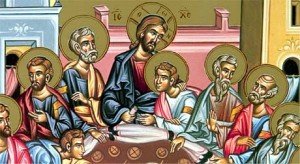I know that in some ways the article has been a little disjointed. I have tried to present some historical information together with some thoughts about the meaning of the Liturgy. I will be taking a slightly different approach during the coming weeks. Hopefully it will all begin to make sense. Some information may be a repetition of information I have already presented but which I feel is critical for a true understanding of the Liturgy.
For example I would stress again that the word church does not mean a place or building but, a gathering or an assembly. To assemble as a church meant, in the minds of the early Christians, to constitute a gathering whose purpose was to reveal, to realize, the Church.
This gathering is eucharistic – its end and fulfillment lies in its being the setting wherein the “Lord’s supper” is made present in time – wherein the eucharistic breaking of bread takes place. In Paul’s letter to the Corinthians he reproaches them for partaking of a meal other than the Lord’s supper in their gathering, or assembling for the purpose other than the eucharistic breaking of bread. He did this because it seems that the meals were getting out of hand (i.e., people were drinking too much) and did not focus on the true meaning of the Lord’s Supper. In the very beginning of the Jesus movement the breaking of bread always took place during a meal in imitation of the Last Supper that Jesus shared with His friends.
From the very beginning we can see an obvious, undoubted tri-unity of the assembly, the eucharist and the Church, to which the whole early tradition of the Church unanimously testifies. The fundamental task of liturgical theology consists, therefore, in uncovering the meaning and essence of this unity.
This task is all the more urgent in that, while this tri-unity was self-evident to the early Church, it has been diminished, many believe, in the consciousness of contemporary Christianity. Too frequently the eucharist is regarded and defined as one of the sacraments, but not as the sacrament of the assembly. Thus it is important that we attempt to return to the original meaning of the Liturgy, namely as the sacrament of the assembly and, hence, the sacrament of the Church. We must think of the Liturgy as the communal worship of us, the local expression of the Church. The Liturgy gives expression to our belief in our communion with our God and our fellowmen. We are truly Church when we join together in communal prayer. The Liturgy is not an act of various individuals but the act of the Church – the assembly of believers in Jesus Christ and the presence of God in our lives.
Think about how you feel when we gather together to pray the Liturgy.

